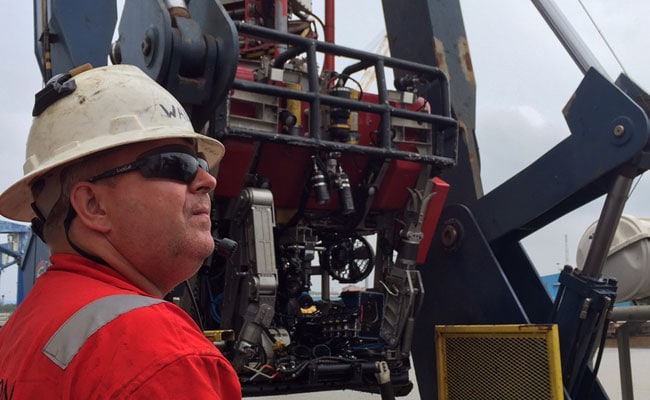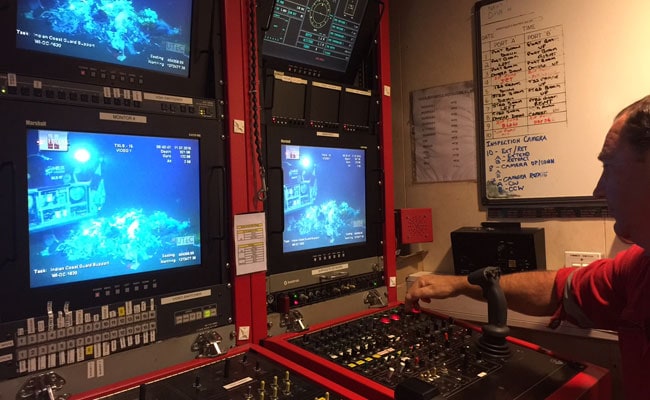
The 4700 ton MSV Olympic Canyon is one of the most advanced ships of her class in the world
Onboard Olympic Canyon:
For more than two decades, Philip Samuel Oakley has worked on the ultra-specialized ships that make deep sea oil and gas field operations possible. It's a tough, regimented life - darkening skies and heavy seas are just some of the dangers that come with a day's work.
But nothing could prepare Mr Oakley and the crew of his ship, the MSV Olympic Canyon, for what they came across in the dark waters of the Bay of Bengal 14 days ago at the crushing depth of almost one kilometer.
"The wreckage is, you know, it's another wreck, but when you see the bones on the seabed, you think that was a person," Mr Oakley, a 54-year-old Australian, said to NDTV.
On June 8, a Dornier reconnaissance aircraft from the Indian Coast Guard disappeared from the radar at Trichy while on a routine night surveillance patrol. Two pilots and a navigator were on board. There was no breakthrough in the search operations despite dozens of sorties by search aircraft and the deployment of several Navy and Coast Guard ships. So the Coast Guard enlisted the help of the Olympic Canyon, which works at the Reliance Industries-BP oil and gas fields in the Krishna-Godavari basin.
That was on June 13.
At 9:24 am on July 10, almost a month later, as the morning crew of the Olympic Canyon were gearing up for another long day of search operations, the moment of truth arrived.
Right there, in front of the lens of one of the two massive Helix Remotely Operated Underwater Vessels (ROVs) deployed from the Olympic Canyon was a propellor blade. 21 minutes later came the biggest breakthrough - the digital flight data recorder of the Dornier loomed right ahead. And with this discovery came the realisation that the mystery over the missing Coast Guard aircraft would finally end. The crew of the Dornier had been missing for 33 days by then.
"It was scary for us. We were apprehensive about what we would find. But we were happy to have been involved with it - to bring closure to the families was foremost in our minds," said Mr Oakley to NDTV, which was allowed exclusive access onboard his ship.

An ROV operator aboard the 4700 ton MSV Olympic Canyon
The search operations were the most intense maritime operations of their kind in Indian waters. The Olympic Canyon's Remotely Operated Vessels, ROVS or Rovers, were sent down, over and over, to the debris field spread over more than two square kilometres at an extreme depth of a more than 990 metres. For a search operation at sea, this is an exceptionally large hunting ground.
The Rovers are exceptionally sophisticated. Equipped with 150 horsepower engines onboard, they are always tethered to the ship, and have a range of sophisticated black-and-white and colour cameras. Each Rover has two claws which can be equipped with a wide variety of tools, have the dexterity and flexibility of a human wrist, and are capable of lifting even an egg without causing any damage. Largely open to sea water, tubes onboard the Rovers are pumped with high-pressure air to balance the crushing pressures associated with operating at extreme depths. The Rovers are controlled from an operations room at the heart of the Olympic Canyon where specialists "fly" them using a fighter-jet like joystick. Another operator using a specialized console works the Rovers' claws underwater. The entire Operations Room inside the Canyon doesn't look unlike a television production control room.

For a week, the Rovers scoured the debris field located 17 nautical miles south east of the Cuddalore coast to recover not just the flight data recorder but also two engines, propellers, tail cone, parts of the fuselage, landing gear and the cockpit voice recorder, which, along with the flight data recorder (otherwise known as the black box) will decisively tell investigators what went wrong in the final moments of the ill-fated flight.
It was the Rovers that also came upon the personal remains of the Dornier's crew members - wrist watches and overalls. The human remains, which include bones, have been sent to forensic specialists in Tamil Nadu. The crew's families say that as tough as it was to confront what was left behind, it also gave them a sense of closure.
Unique in the waters of the Bay of Bengal, the 4700-tonne MSV Olympic Canyon, which has been contracted by Reliance Industries Limited and British Petroleum, is one of the most advanced ships of her class in the world. Operated by a multinational crew, she profiles the sea bed, inspects undersea oil and gas fittings, installs and replaces sub-sea components when required, and tracks the condition of undersea pipes, largely through the use of her two Rovers.
Timmie Shed, the Head of RIL's Deep Water Project, tells us, "The Olympic Canyon brings the ability in these waters to inspect, survey, do construction up to 3000 meters depth which is required for the operations of the KGD6 fields. She is the only vessel available in Indian waters with ROV capability. So she was called upon."
While the Olympic Canyon may have made the final breakthrough, a fact appreciated by the Government, the mission was ultimately successful because of the gigantic team-effort that involved the Coast Guard, the Indian Air Force, the National Remote Sensing Centre, the National Institute of Ocean Technology and most significantly, the Indian Navy's Kilo Class submarine, the INS Sindhudhwaj.
Deployed for the search operations, the Sindhudhwaj was able to hone in to sporadic signals from the emergency locator beacon of the ill-fated Dornier with great accuracy, unlike search aircraft and other ships which had picked up sporadic pings but were unable to pinpoint the specific crash site. NDTV has learned that despite technical trouble, the Sindhudhwaj pressed ahead with her submerged operations and locked onto the 37.6 MHZ signal from the Dornier's flight data recorder. These coordinates were then forwarded to the crew of the Olympic Canyon which made the ultimate breakthrough.
But nothing could prepare Mr Oakley and the crew of his ship, the MSV Olympic Canyon, for what they came across in the dark waters of the Bay of Bengal 14 days ago at the crushing depth of almost one kilometer.
"The wreckage is, you know, it's another wreck, but when you see the bones on the seabed, you think that was a person," Mr Oakley, a 54-year-old Australian, said to NDTV.
On June 8, a Dornier reconnaissance aircraft from the Indian Coast Guard disappeared from the radar at Trichy while on a routine night surveillance patrol. Two pilots and a navigator were on board. There was no breakthrough in the search operations despite dozens of sorties by search aircraft and the deployment of several Navy and Coast Guard ships. So the Coast Guard enlisted the help of the Olympic Canyon, which works at the Reliance Industries-BP oil and gas fields in the Krishna-Godavari basin.
That was on June 13.
At 9:24 am on July 10, almost a month later, as the morning crew of the Olympic Canyon were gearing up for another long day of search operations, the moment of truth arrived.
Right there, in front of the lens of one of the two massive Helix Remotely Operated Underwater Vessels (ROVs) deployed from the Olympic Canyon was a propellor blade. 21 minutes later came the biggest breakthrough - the digital flight data recorder of the Dornier loomed right ahead. And with this discovery came the realisation that the mystery over the missing Coast Guard aircraft would finally end. The crew of the Dornier had been missing for 33 days by then.
"It was scary for us. We were apprehensive about what we would find. But we were happy to have been involved with it - to bring closure to the families was foremost in our minds," said Mr Oakley to NDTV, which was allowed exclusive access onboard his ship.

An ROV operator aboard the 4700 ton MSV Olympic Canyon
The search operations were the most intense maritime operations of their kind in Indian waters. The Olympic Canyon's Remotely Operated Vessels, ROVS or Rovers, were sent down, over and over, to the debris field spread over more than two square kilometres at an extreme depth of a more than 990 metres. For a search operation at sea, this is an exceptionally large hunting ground.
The Rovers are exceptionally sophisticated. Equipped with 150 horsepower engines onboard, they are always tethered to the ship, and have a range of sophisticated black-and-white and colour cameras. Each Rover has two claws which can be equipped with a wide variety of tools, have the dexterity and flexibility of a human wrist, and are capable of lifting even an egg without causing any damage. Largely open to sea water, tubes onboard the Rovers are pumped with high-pressure air to balance the crushing pressures associated with operating at extreme depths. The Rovers are controlled from an operations room at the heart of the Olympic Canyon where specialists "fly" them using a fighter-jet like joystick. Another operator using a specialized console works the Rovers' claws underwater. The entire Operations Room inside the Canyon doesn't look unlike a television production control room.

For a week, the Rovers scoured the debris field located 17 nautical miles south east of the Cuddalore coast to recover not just the flight data recorder but also two engines, propellers, tail cone, parts of the fuselage, landing gear and the cockpit voice recorder, which, along with the flight data recorder (otherwise known as the black box) will decisively tell investigators what went wrong in the final moments of the ill-fated flight.
It was the Rovers that also came upon the personal remains of the Dornier's crew members - wrist watches and overalls. The human remains, which include bones, have been sent to forensic specialists in Tamil Nadu. The crew's families say that as tough as it was to confront what was left behind, it also gave them a sense of closure.
Unique in the waters of the Bay of Bengal, the 4700-tonne MSV Olympic Canyon, which has been contracted by Reliance Industries Limited and British Petroleum, is one of the most advanced ships of her class in the world. Operated by a multinational crew, she profiles the sea bed, inspects undersea oil and gas fittings, installs and replaces sub-sea components when required, and tracks the condition of undersea pipes, largely through the use of her two Rovers.
Timmie Shed, the Head of RIL's Deep Water Project, tells us, "The Olympic Canyon brings the ability in these waters to inspect, survey, do construction up to 3000 meters depth which is required for the operations of the KGD6 fields. She is the only vessel available in Indian waters with ROV capability. So she was called upon."
While the Olympic Canyon may have made the final breakthrough, a fact appreciated by the Government, the mission was ultimately successful because of the gigantic team-effort that involved the Coast Guard, the Indian Air Force, the National Remote Sensing Centre, the National Institute of Ocean Technology and most significantly, the Indian Navy's Kilo Class submarine, the INS Sindhudhwaj.
Deployed for the search operations, the Sindhudhwaj was able to hone in to sporadic signals from the emergency locator beacon of the ill-fated Dornier with great accuracy, unlike search aircraft and other ships which had picked up sporadic pings but were unable to pinpoint the specific crash site. NDTV has learned that despite technical trouble, the Sindhudhwaj pressed ahead with her submerged operations and locked onto the 37.6 MHZ signal from the Dornier's flight data recorder. These coordinates were then forwarded to the crew of the Olympic Canyon which made the ultimate breakthrough.
Track Latest News Live on NDTV.com and get news updates from India and around the world

